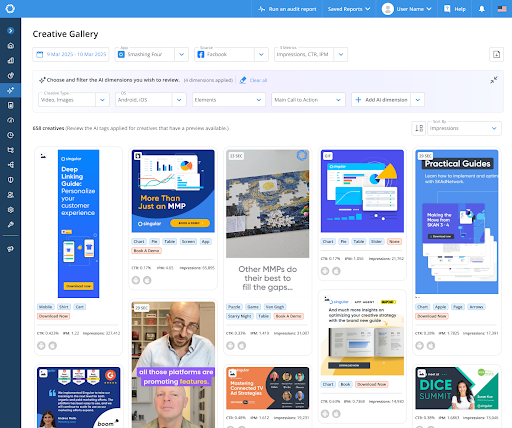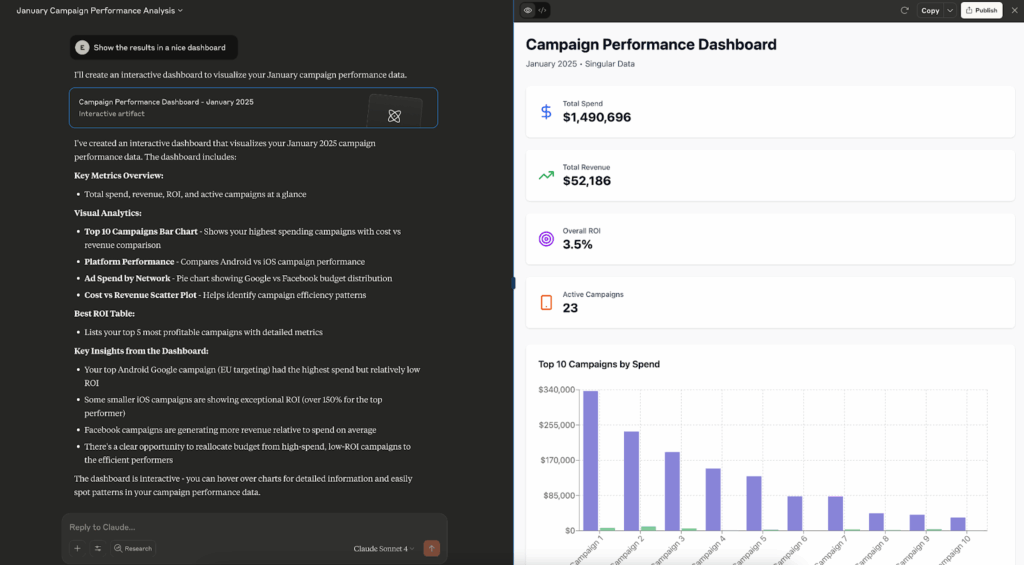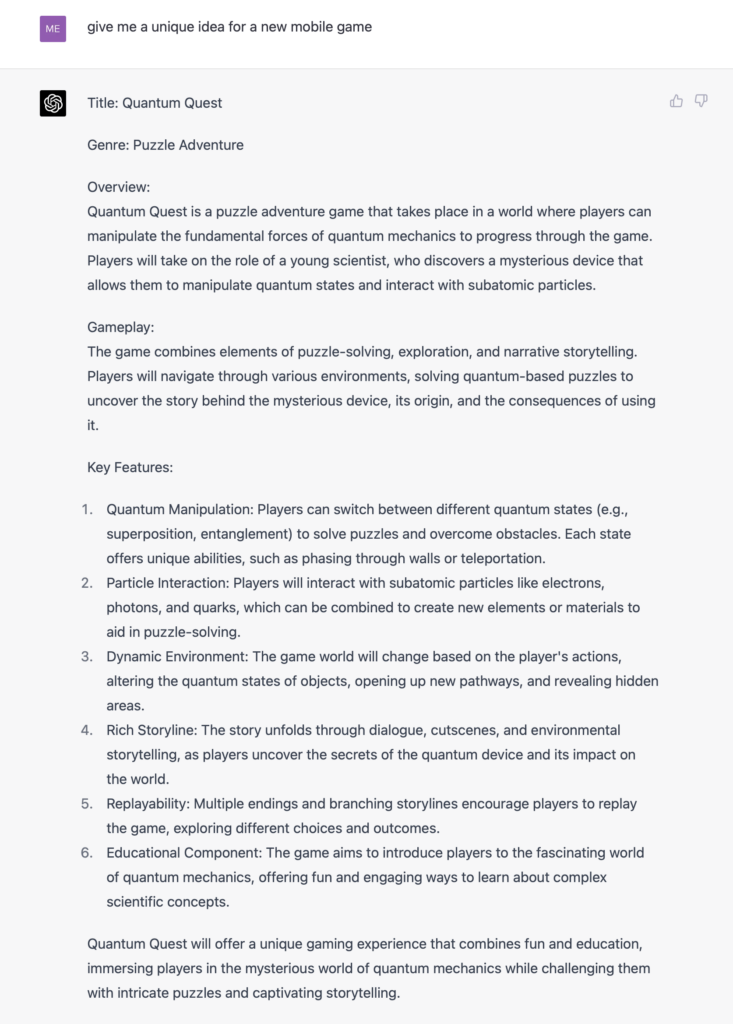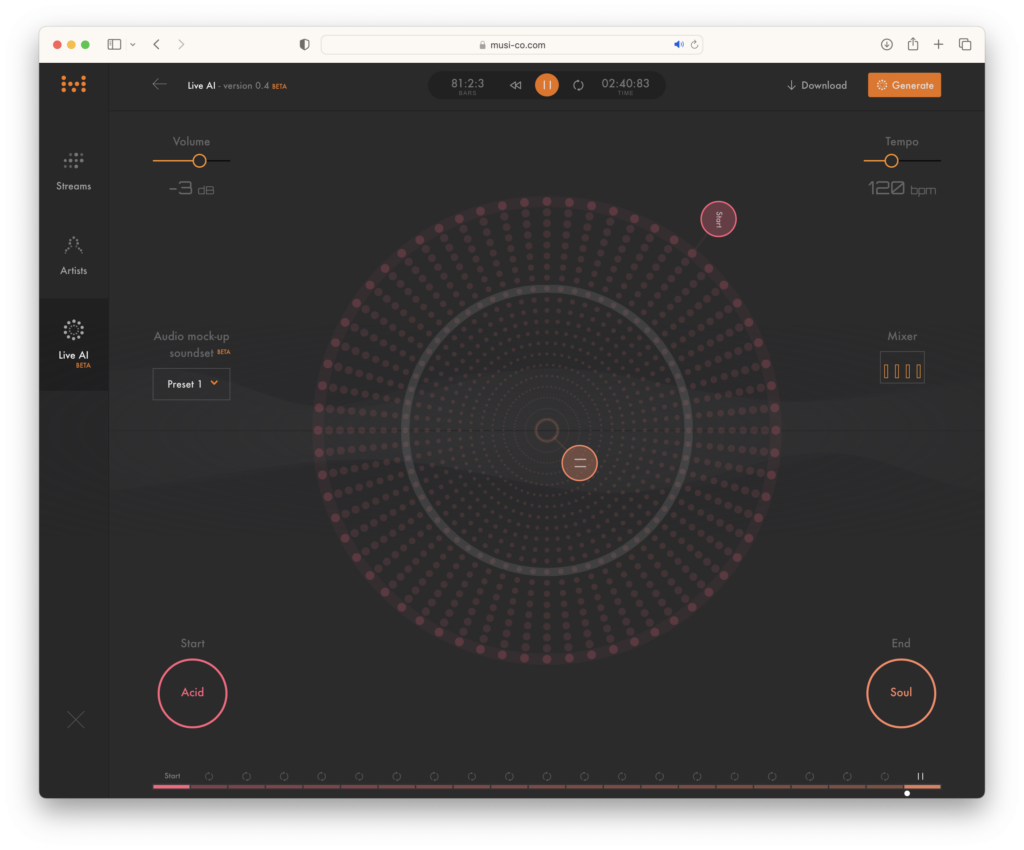Generative AI for marketing: 17 tools for app growth
Generative AI for marketing is getting really, really good in 2025.
Creative is of course the ultimate fantasy. Inspired by Star Trek’s Jean-Luc Picard, we’ve always dreamed of the ability to literally speak reality into existence. And while we don’t have a Holodeck and we’re not quite there yet for “Tea, Earl Grey, hot,” (atoms are hard!) we’re actually been given shockingly impressive powers with generative AI. Text, images, video, Python code, trip itineraries, sweet sentiments for significant others on Valentine’s day, entire apps … all of that is possible with generative AI today.
It’s probably not perfect, but it is available.
Sometimes it’s shockingly good. And we’re just getting started. And generative AI for marketing is entering prime time.
A storyteller I interviewed a few years ago used generative AI to create images and video and audio for interactive podcasting. At the time, she compared our present era to the first phones with onboard cameras … the 1.5 megapixel ones. (Remember, the same ones Kodak laughed and dismissed as toys.)
Today everything is different. We’re no longer at the crappy 1.5 megapixel smartphone camera era. We’re in the era when 100% straight up you can use generative AI for marketing and get frankly amazing results. Probably not as good as a great designer, let’s be honest, but still almost unbelievably good.
That’s kinda the scary part. It’s now as bad as it ever will be. It will only get better from here.
(How good can it get?)
There is a lot you can do today with the current state of the art in generative AI to help with marketing. I regularly use ChatGPT to auto-create a summary of a podcast episode. It takes 2% of the time that it would take to do manually. Most of you use ChatGPT, or Claude, or Gemini, to do similar things. This is now normal, basic, unsurprising, and expected.
Before I share a few tools that can help you, however, let’s see what the big machine in the cloud says first. Because … there simply has to be some generative AI in a post about generative AI, right?
ChatGPT: what generative AI says about using generative AI for marketing
Why yes, I did ask ChatGPT for its opinion on using generative AI for marketing. Here’s what ChatGPT “thinks” about the potential.
Generative AI, like GPT-4, has the potential to revolutionize the marketing landscape in various ways. While some of these implications have already been observed, more applications will likely emerge as the technology evolves.
Here are some ways generative AI can impact marketing:
- Content creation:
Generative AI can create high-quality, engaging, and contextually relevant content at scale, including blog posts, social media updates, and email campaigns. This can save time and resources for marketing teams, allowing them to focus on strategy and analysis. - Personalization:
AI-powered marketing tools can analyze customer behavior and preferences to create personalized content and offers, enhancing customer experience and increasing conversion rates. This technology can make recommendations based on a user’s browsing history, previous purchases, or other interactions with a brand. - Ad copy and design:
Generative AI can help create and optimize ad copy and design elements, testing various combinations to identify the most effective messaging and visuals. This can lead to better performing ads, higher click-through rates, and improved return on investment (ROI). - Chatbots and virtual assistants:
AI-powered chatbots and virtual assistants can help brands engage with customers in real-time, answering queries, offering support, and providing personalized recommendations. This not only improves the customer experience but also frees up human resources for more complex tasks. - Market research and analysis:
Generative AI can analyze vast amounts of data, identifying patterns and trends that can inform marketing strategy. This can help brands understand their target audience, stay ahead of competitors, and identify new opportunities. - Social listening and sentiment analysis:
AI can monitor social media platforms, news articles, and forums to gauge public opinion and sentiment about a brand, product, or service. This information can help marketing teams respond to customer feedback and adjust their messaging accordingly. - Predictive analytics:
Generative AI can help marketers forecast customer behavior and demand, enabling them to optimize pricing, inventory, and promotional strategies. - Influencer marketing:
AI can help identify suitable influencers for a brand based on the influencer’s audience demographics, engagement rates, and other factors. This can help brands form more strategic and effective partnerships. - Creativity augmentation:
AI can assist marketing professionals by generating creative ideas or providing inspiration for campaigns, allowing for more innovation and outside-the-box thinking.
A bit vanilla, sure. Maybe less personality that we might like, and perhaps a bit short on details and links, but not a bad summary. So: where’s the beef? What are the tools you can use today to help you grow your apps?
Here’s a short list that I intend to keep adding to over time … (with 6 brand-new tools just added!)
Generative AI tools for app growth and marketing
Generative AI for optimizing ad creative
Sorry, but we can’t ignore our own tools here! Singular recently released Creative IQ, an AI-powered creative optimization suite makes testing, tagging, and reporting creative results amazing and easy.
Creative IQ lets you analyze the results of your A/B tests better than ever before, automatically categorizes your ad creative with smart tags based on what’s actually in the images, and offers simple visual reporting: videos and images side-by-side with performance metrics.

Creative IQ gives marketing and creative teams the granular, visual, and actionable insights they need to deliver better creative that performs.
Generative AI for marketing measurement and reporting
Wouldn’t you like to just talk to your marketing measurement platform and get all your results served up on a platter?
Now you can, because we (yep, this is another Singular tool) have integrated with Claude (and soon other platforms) to get your marketing results, charts, insights, and suggestions right from a super-powerful but super-simple chatbot.

No SQL or Python needed: you can just talk to your attribution engine. Thousands of marketers already are, and they’re learning incredible insights that sometimes, you wouldn’t even think to check via your dashboard.
Simple and powerful … exactly what we want from AI.
Generative AI for objects or people in your game
You would typically need some skill for game asset generation. With PixelVibe, you let the machine do all the work for you. And yeah, that can be people, props, concepts, environments, weapons, skins or clothing … even graphical user interfaces.
From Rosebud, the company behind Pixelvibe:
“Rosebud is building the AI Roblox. We will make it 1000X easier for a community of game devs to create and enjoy the games of their dreams … we believe all media creation will be done via generative methods in a few years.”
All is a big word. But maybe …
Pick a “potion model” to select the types of objects you want, enter your prompt, choose an image size and the number of images you want. Here’s “ancient city crumbling into the desert” at 512×512 pixels. It’s not for a hi-res game, but it’s pretty cool. You can pixelate it, “re-vibe” it for a different look and feel, or remove the background:

And, if you want 3D worlds, check Rosebud.ai to generate them.
Generative AI for marketing copy
Writing copy for 500 different variations of my so good most awesomest app ever is soul-crushing. But only humans have souls, fortunately. Microsoft says AI can do it, thanks to its multi-billion-dollar investment in OpenAI and ChatGPT.
Via AdWeek:
“Microsoft has begun to integrate models like GPT-4 and image generator Dall-E 2 from OpenAI, in which it has heavily invested, into its Azure enterprise cloud computing services. Microsoft has also partnered with Adobe to supply its language AI to help write marketing messages and photo captions within the latter’s marketing platform.”
In other words: there’s startups, and there’s enterprise. Both are building AI tools to automate marketing tasks.
Or you can just use OpenAI’s ChaGPT right from the source. Here’s ChatGPT in response to my “give me an exciting and persuasive marketing blurb for my spaceship shooter game” prompt:
“Prepare for liftoff, Captain! Step into the cockpit and unleash your firepower in [Game Name], the ultimate intergalactic spaceship shooter that will ignite your senses. Battle through explosive galaxies, face relentless alien forces, and customize your ship with cutting-edge weapons. Whether you’re seeking epic boss fights, immersive cosmic landscapes, or the thrill of becoming the galaxy’s greatest pilot, [Game Name] delivers heart-pounding action that keeps you on the edge of your seat. Ready to conquer the stars? Your mission awaits—download now and become a legend of the skies!”
It’s not horrible. And it’s perfectly easy to edit to exactly what you want … without the stress of staring at a blank sheet of paper for hours wondering what to say.
Generative AI for personalized calls to action
Getting some of your revenue via ads is great, but it also impacts your gameplay or app user experience. In-app purchases and especially subscriptions promise bigger rewards, but you need to appeal to people persuasively.
From Persado, the “Generative AI Platform to motivate every individual to engage and act:”
“Determine the messages that drive the highest levels of engagement and conversion through advanced decisioning and machine learning experimentation … uncover the nuanced narratives that resonate with your customers in specific scenarios across the entire journey … optimize the messages each customer receives with powerful set-and-forget adaptive technology.”
Almost scary, but very intriguing.
Persado will build an LLM just for you with the right language, tone, and emotion, which you can then feed into your mobile CRM or live ops solution.
Generative AI for new app and game ideas
Coming up with creative ideas for new games is HARD. I mean, how many times can you do a merge meets battle meets puzzle meets dating game mashup? (Once was more than enough, apparently.)
So ask ChatGPT for new ideas for a unique game.
I just did, and the hundreds of thousands of GPUs at OpenAI came back with this super-geeky nerd gem: The Quantum Quest, a “puzzle adventure game that takes place in a world where players can manipulate the fundamental forces of quantum mechanics to progress through the game.”
Sweet.
(Interestingly, GPT-4 thinks “cut scenes” should be “cutscenes.”)

Definitely nerdy, but not too bad, either. Rinse and repeat until you get an option you love, then get some help coding it from
Generative AI for user and customer journeys
Figuring out and mapping customer journeys is complicated and tiresome. Get AI to do it, with Adobe’s Sensei platform.
From Adobe:
“Get AI-enhanced capabilities in Adobe Journey Optimizer that are trained on customer journeys, offers, and experience events to increase engagement with customers.
Perhaps more enterprise-y, but will certainly have applications for dev ops tools and certain to hit tools like Braze and CleverTap soon enough. Probably best for those who are cross-platform with web, apps, and other channels that they need to synchronize messaging across.
Generative AI for copywriting that makes money
There’s a lot of story in some games. And a lot of times, you want to encourage users or players or customers to do something, click on a button, and part with some juicy cash.
So make copy that converts with AI.
From Jacquard, formerly Phrasee:
“Technology like Phrasee is to copywriting what Photoshop was to design.”
Plus, of course, you can use something like this for ad copy generation. The key thing you get from Jacquard: “hyper-personalized brand communications.
Generative AI for videos
Videos can be hard to make and they cost a lot of money and time and focus. Make them instantly from plain text with generative AI.
Sure, these could be for marketing. But they could also be part of your app: sarcastic congratulations from Master Chief in a space battle game, soothing, calming, gentle and positive support in a meditation app, in-your-face screaming yelling Tony Robbins for a tech bro motivation app.
Think something like this:
From Synthesia:
“Our mission is to empower everyone to make video content – without cameras, microphones or studios. Using AI, we’re here to radically change the process of content creation and unleash human creativity for good.”
Deepfakes are some scary tech. But you can use them for good for characters you create in your apps.
That’s one option. I’ve seen HeyGen do some absolutely incredible things as well: train it on you, and it generates almost fully believable video with “you” speaking on-screen. Very impressive.
Runway is also doing some incredible work:
- generative video
- generative audio
- lip syncing
- super slo-mo
- depth of field
- and much more …
Generative AI for music
A game without a soundtrack sucks. But musicians are expensive, and copyright-free stock riffs are pretty much that: stock. So create some cool jams with generative AI for music.
Maybe you can even generate a soundtrack that has always unique style to your game or app, but also adapts to individual players’ or users’ progress, actions, and success or failure.

From Musico:
“Musico’s engines can generate infinite melodies, beats and harmonies, blending autonomy and responsiveness to the creator’s input … we’re exploring the relation between music and narrative to develop a next generation soundtrack plugin for storytellers, game, and cross-media developers.”
A unique sound for your app that isn’t just one track endlessly looping? Novel idea, and one whose time has come.
Generative AI for clothes in a fashion or social game
Wearing the same thing all the time gets old fast, even in the metaverse. Give your in-game avatars more choice and more creativity with generative AI that’s completely free.
From ClothingGAN, a free repository on GitHub:
“ClothingGAN is able to generate clothing images and mix these images. While mixing, you can control which structure or style that you want the clothing to copy. Additionally, you can edit the generated clothing with several given attributes such as dark color, jacket, dress, or coat.”
In-app purchases, anyone?
HeyGen also offer capabilities like this, as does Ready Player Me
Generative AI to create entire levels or worlds
There’s already procedural generation for infinite-scale games like No Man’s Sky. Upleveling that to full generative AI is the next step to making virtual spaces bigger, more detailed, more real, and more responsive to both game developer and user desires. That makes generative AI a key cog in enabling metaverse-style instant rooms, spaces, planets, or pretty much anything for MMORPGs.
Ready Player One isn’t going to build itself … or is it?
From a session at GDC 2023 with Roblox studio chief Stef Corazza:
“Roblox envisions a future where anyone can create anything, anywhere … the next step in this journey is leveraging AI to help professional game development studios push the limits of what’s possible on the platform—with high-fidelity experiences that reach a massive global audience of millions in seconds.”
In fact, we’ve interviewed the chief scientist at Roblox, and he’s convinced people will be able to create entire games via voice prompts.
See this:
But wait, there’s more …
As promised, this is a living list. And since the original post dropped, a few new contenders have joined the lineup — some brand new, others rapidly evolving.
So let’s keep it rolling with five more generative AI tools that are worth a little excitement:
Generative AI for explainer videos and product demos
Tool: Pika
Making launch videos that don’t suck is hard. Making launch videos that people want to watch? Even harder. With Pika’s generative video, you start with a text prompt and end with seriously professional-looking short-form animations. You can create walk-throughs, social snippets, or in-app explainers without a full creative team or a three-week timeline.
It’s still early-stage, but it’s already powerful enough to impress even the most over-it, anti-AI designer on your team. And it’s getting better with every release.
Generative AI for background removal and smart editing
Tool: Clipdrop by Jasper
Sometimes, you just need to zap an ugly background, drop in a clean replacement, or make the product pop on your ad creative. Clipdrop takes the drudgery out time-consuming, mundane design tasks, trained on massive vision models and built for fast, intuitive edits.
It does cleanup, relighting, upscaling, object removal, and even prompt-to-image generation. That can save a lot of back-and-forth on those final, miniscule edits.
Sure, Canva can remove backgrounds, but this does it at scale.
Generative AI for campaign-level creative strategy
Tool: Writer
Way more robust than Grammarly, Writer is a powerful platform for brand-safe generative content that’s tuned to your style guide and voice. That means anybody on the team, from the intern to the project manager, can quickly produce copy that aligns to brand standards and tone.
It’s like ChatGPT with guardrails, structure, and an editor that actually knows your brand voice. Plus, it plays well with office suites (like Google and Microsoft) and marketing platforms, making it easier to integrate with enterprise workflows and content pipelines.
Generative AI for dynamic image generation
Tool: Ideogram
Stock photos are, at worst, corny and, at best, boring. And AI-generated images can be overly slick and creepy, never mind the whole hands thing.
Good AI images, though? That’s another story. Ideogram turns short text prompts into visually unique, brand-right images, and it has a special knack for actually generating legible text inside images. (If you’ve ever tried creating an image with text in Canva or Dall-E … you know.)
The images are pretty awesome, and some are barely identifiable as AI. You could definitely lose a few hours creating memes that don’t look like they were made in 2010.
Generative AI for synthetic user personas
Tool: Synthetic Users
Looking for real-world feedback on your app or rebrand without actually booking interviews or focus groups? Synthetic Users lets you simulate interviews, tests, and user journeys using AI agents modeled on real demographics and behaviors.
This goes beyond wondering how users might interact with your product or campaign, it allows you to actually watch them do it, click by click, prompt by prompt. Marketers and PMs use it to test messaging, onboarding flows, landing pages, and more, long before the real humans get involved. Faster feedback, fewer wrong turns.
Overview of generative AI tools for marketing and app growth
| Tool name | Category | Description |
|---|---|---|
| Creative IQ | Ad creative optimization | AI-powered creative tagging, A/B test analysis & performance insights by Singular |
| Claude + Singular | Marketing measurement | Chatbot interface for marketing analytics—get charts, data, insights without dashboards |
| PixelVibe | Game asset generation | Generate game characters, items, GUIs, and environments from prompts |
| ChatGPT / Microsoft / Adobe | Marketing copy | Automated generation of marketing blurbs and campaign messaging |
| Persado | Personalized calls to action | AI-powered message optimization using language and emotion models |
| ChatGPT | New app & game ideas | Generate original concepts like “Quantum Quest” with simple prompts |
| Adobe Sensei | Customer journey mapping | AI-enhanced journey optimizer across channels |
| Jacquard | High-converting copy | Hyper-personalized ad and in-app messaging for conversions |
| Synthesia / HeyGen / Runway | Video generation | Text-to-video tools for marketing, in-app cutscenes, or branded avatars |
| Musico | Music creation | Adaptive game soundtracks based on user actions |
| ClothingGAN | AI-generated outfits | Create in-game fashion items; mix & edit styles for social/fashion games |
| Rosebud.ai / Roblox | World & level generation | Create full 3D experiences and game environments via prompts |
| Pika | Explainer video creation | Fast, AI-generated animations and demo videos from plain text |
| Clipdrop | Smart image editing | Remove backgrounds, relight, upscale images, generate from prompts |
| Writer | Brand-safe content | Enterprise writing tool aligned with your brand voice & style guide |
| Ideogram | Image generation with text | Create visually striking images with actually legible embedded text |
| Synthetic Users | UX simulation & persona testing | AI-generated test users that simulate behavior across journeys and landing pages |
More to come, I’m sure
That’s the latest crop. If you’re using something magical (or weird or brilliant) that should be on this list, let me know … I’m happy to add more.
The innovation is just getting started, and this list could (probably will!) keep growing.
Stay up to date on the latest happenings in digital marketing


